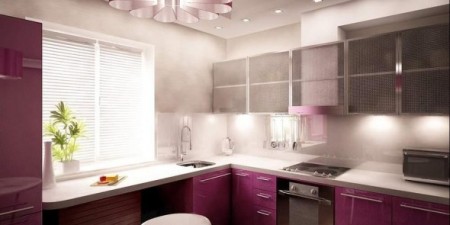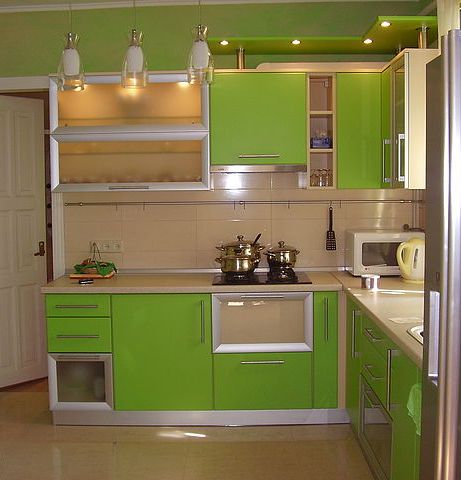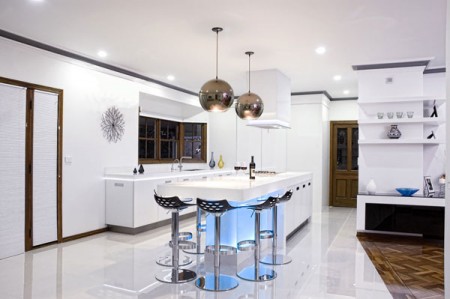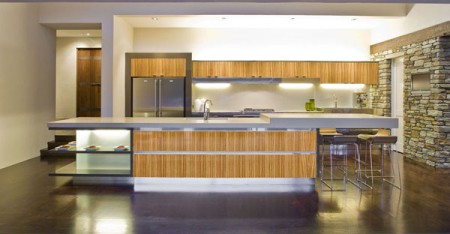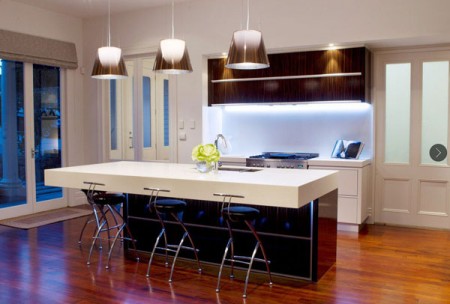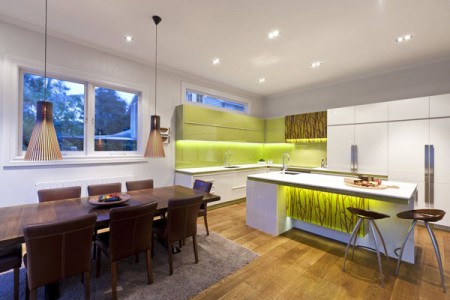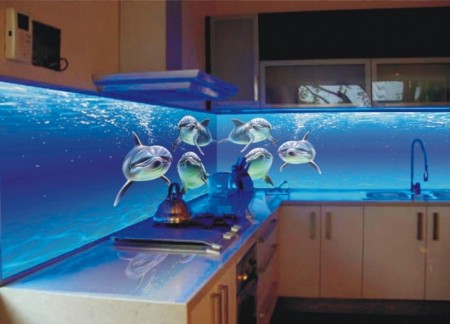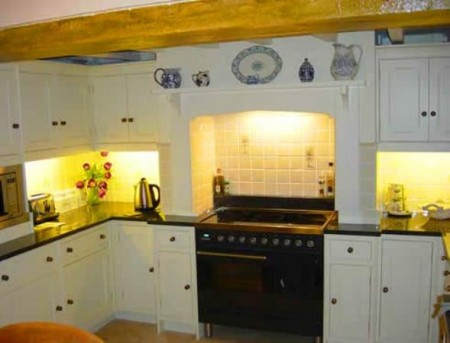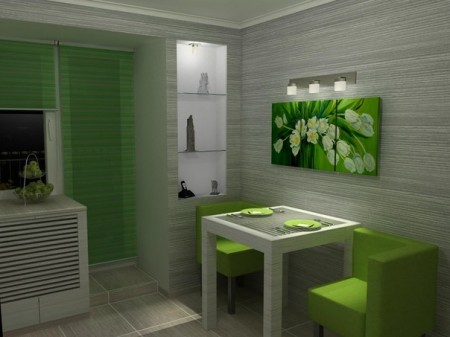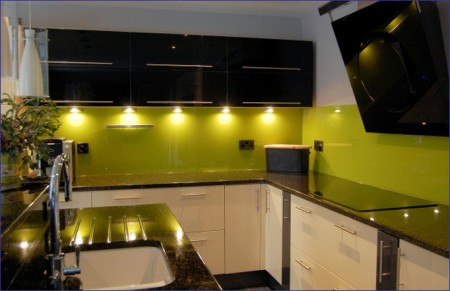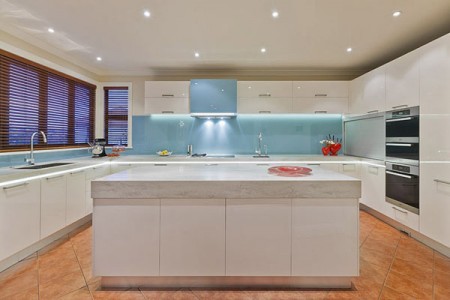One of the most popular and often visited rooms in the house is the kitchen. All tenants spend a lot of time in it. At one time, in order to drink a cup of aromatic coffee and get distracted from pressing problems or prepare food, others - to sit with friends or have dinner with all members of the family. In order to add extra comfort to the kitchen, you need to choose the right lighting.
Content
Kitchen lighting
First, you need to know that light design is based on certain mandatory requirements. Light can be both natural and natural. Quite often these two types of lighting successfully combine.
The installation of light must be thought out in such a way that it can guarantee the illumination of every object in the kitchen. But in parallel with this, the light
- should not be too bright,
- should not make a strong shadow,
- on the contrary, it must be organic and thoughtful.
It is generally accepted that the norm for a kitchen of general light should be 100 lux of illumination, and the norm for local light is 300 Lux.
The abundance of natural daylight depends on the following factors:
part of the light on which the kitchen window opens, the clarity and transparency of the windows, the color scheme of the room.
For the evening time, artificial lighting makes it quite bright, but in no time dazzling.
In the kitchen, lighting should be organized on the same level. In other words, to create such a single-level lighting, the lower and upper light sources need to be arranged reasonably well. Light from sources to illuminate the walls should be muted and slightly scattered.
Kitchen lighting design
In such a room as a kitchen, there are three types of lighting: decorative, local and general. Buying lighting equipment you need to understand for which specific zone exactly which device is most suitable, where and how it will look most harmoniously and where and what is important to highlight more vividly or vice versa more absent-mindedly.
Experts advise first of all to choose lighting devices for a working area of a kitchen premise. The next stage is a device for lighting a table intended for dinners. After all, this place is second in the list of the most used in the kitchen area. Then you should choose a chandelier, to provide general lighting. At the very least, you need to choose the fixtures to create a decorative backlight.
In turn, the lamps used in the above listed fixtures are divided into four types: LED, vacuum, luminescent and halogen. Typically, the lamp characteristic is indicated by the power indicator. Although different types of lamps with the same indicators emit absolutely different level of illumination. It will be better if before making a purchase compare the lamps by the amount of light given out. The light output is determined by the amount of light per 1 kW of power spent.
Lamps vacuum
Vacuum incandescent bulbs - the most ordinary and familiar kind of light bulbs. Manufacturers produce their various forms. This fact is positive, because different shapes make it possible to choose a suitable luminaire for a particular model.
This is by no means the last positive fact that these lamps possess. They also have different power from 15 W to 300 W, are not expensive, are not considered a scarce commodity, their production is not associated with the use of toxic substances. Unfortunately, they have their drawbacks: for their operation, not small expenses of electric energy are required while they are very hot, they are very fragile (they can easily be broken), they have a relatively short life and a small efficiency factor.
Halogen lamps
Often, halogen lamps are used in the following way: they are built into kitchen furniture for additional lighting, for interior lighting of stretch ceilings, as well as in luminaires called spotlights. The main positive aspects of this type of lamps are the following: relatively long life, bright but simultaneously "cozy" for the eyes emitted light, resistance to temperature changes and mechanical influences, higher than conventional light output, and also belongs to the category of energy-saving ones.
This type of main minus lamp has only two: very much increase its temperature in the switched on state and high susceptibility to voltage fluctuations in the network. The cost of these lamps is about four times the cost of vacuum lamps.
Luminescent lamps
This kind of lamps is arranged as follows - upon start-up, the combustion of mercury vapor begins, and the luminescence begins to glow through it. The main and powerful advantage of this type is considered to be the light emitted as close as possible to the X-ray spectrum of the sun's rays.
In addition, this species is famous for its maximum performance, long service life, minimum incandescent temperature, a wide choice of sizes and shapes. By cons are:
- audible buzzing directly in the process of work,
- sensitivity to differences in the network,
- use of toxic substances in the production process and not at all low cost.
LED Kitchen Lighting
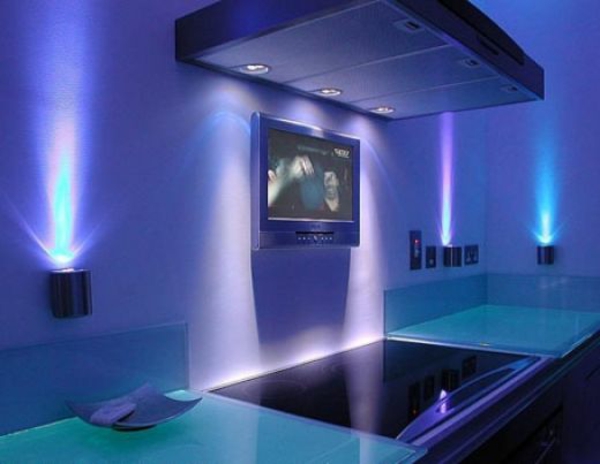
LED lamps are rightly recognized as the most progressive type. Widely available on sale have become relatively recent. Huge popularity was gained due to the following moments:
- minimum power consumption,
- a sufficiently long period of use,
- not a rise in temperature during operation,
- high resistance to vibration,
- absolute harmlessness for humans, because they have absolutely no toxic substances and a minimum level of IR and UV radiation. However, it is not easy to find them in specialized stores and among all the types of lamps considered, with the highest cost.
Lighting the ceiling of the kitchen
To date, the concept of how to illuminate the kitchen has changed greatly, for example, compared with the concepts of a decade ago. Now it is not at all relevant and it is not enough to hang an ordinary bulb or cover it with a plafond. Today, the solution of the issue is suitable with responsibility and scrupulousness. And designers offer a variety of lighting options. Let's look at some of the most commonly used ones.
Placed in the center of the ceiling chandelier or ceiling lamp. In this example, echoes of an ordinary light bulb through the center of the ceiling appear. Although, if you choose the right size and fit to the overall design in a proper way, correctly place it, choose a plafond with a certain pattern and structure, adjust the power and type of lamps, then it is realistic to get an effective and original result. Mounting in this example is quite simple and not at all complicated. But the disadvantage of including such coverage will be the appearance of shadows that prevent the execution of the planned works in the kitchen.
In case of insufficient daylight, such as an inconvenient window arrangement or cloudy rainy weather, it is best to use a fluorescent lamp as an additional light source. In the evening, its light will be too bright for the eyes. This effect doubles when the kitchen is small.
Luminaire for ceiling equipped with swivel lights. Its operation will provide an excellent opportunity to highlight specific areas of the kitchen. But the resulting heterogeneity of light will affect the eyes. They will quickly get annoyed by this kind of lighting.
But the next option - lighting the kitchen area with the help of spotlights located on the entire perimeter of the ceiling surface. This option is the most common and fashionable. Such an arrangement of light points equally directs the rays of light and will not give shadow effects. This type of lighting is not badly combined with the first option considered.
Small Kitchen Lighting
It makes no sense to mount a large number of light points in a small kitchenette. It will make more sense if the general light is above the table intended for meals. The use of a variant with the placement of point light along the perimeter of the ceiling area is also inappropriate in this case because of the numerous lockers on the walls.
In the proposed conditions it will be appropriate to place lamps with a spotlight specifically under the lockers. There is another way of placing a spot light - provided that the doors of cabinets with glass inserts, interesting and original, will put the bulbs behind them. Also an interesting solution would be a very convenient mobile lamp with a wire frame. They can move in certain directions or change the course of the light beam to the desired side or to the desired object.
Correct lighting of the kitchen - we plan to illuminate the working area
To illuminate the working area in the kitchen, one medium-sized lamp, equipped with an LED lamp, is enough. If the kitchen furniture is equipped with a hood, then problems with lighting the work area will not arise. The light built into the hood can easily cope with the task.
Experts advise you to listen to the following recommendations:
- mounting any of all kinds of lamps, remember that he should not blind his eyes;
- give light attention to the corners under the lockers - they are also desirable to illuminate;
- kitchen rooms with low ceiling do not oversaturate with lighting equipment;
- adhere to the correct light range of light - the color of the rays from the lamps should be as close to the natural as possible, so as not to change the color of the products;
- for certain reasons, which do not make it possible to use point light, it can be completely replaced by lamps that are elongated in shape;
- in small kitchens to strive for maximum availability of glossy and light surfaces - they will visually add light in the room;
- dark not illuminated kitchen apron at least in three will reduce it in comparison with the apron, made in light colors;
- the advantage of light tones in the finish and in the kitchen furniture plus a properly selected light visually increase it and vice versa, the advantage of dark tones and the wrong light - will significantly reduce.



